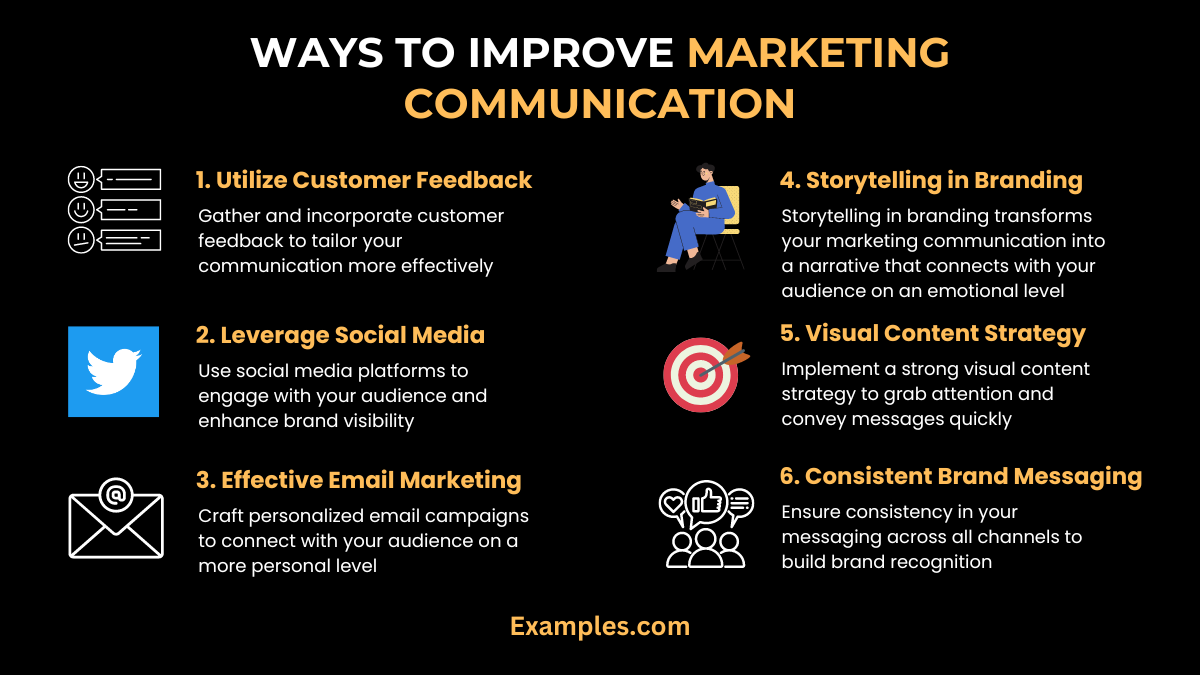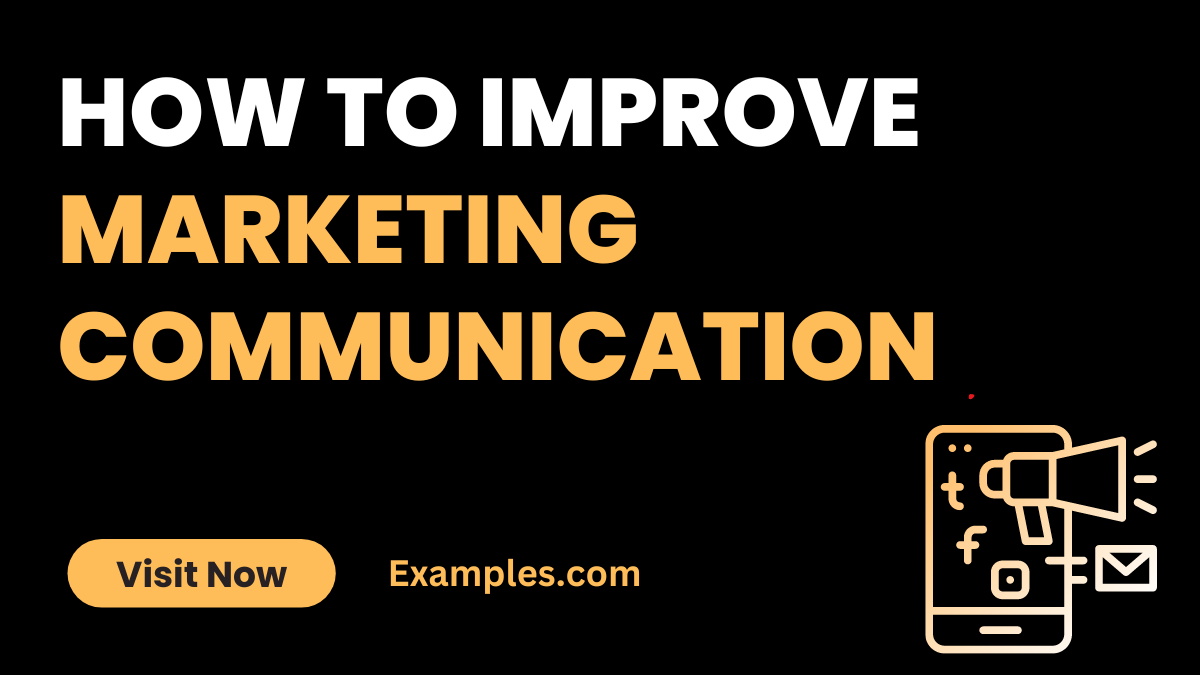How to Improve Marketing Communication?
In today’s fast-paced digital world, improving marketing communication is vital for any brand looking to stand out. This guide delves into practical strategies enriched with Marketing Communication Examples to enhance your messaging. From leveraging digital platforms to understanding audience nuances, we provide insights to refine your communication tactics. You’ll learn how to craft messages that resonate, ensuring your marketing efforts don’t just reach but also engage your target audience effectively.
10 Ways to Improve Marketing Communication

- Utilize Customer Feedback: Gather and incorporate customer feedback to tailor your communication more effectively.Integrating customer feedback into your marketing communication is a powerful way to align your strategies with your audience’s needs and preferences. By actively seeking and responding to feedback, you demonstrate that you value customer opinions, leading to more tailored and effective marketing efforts. This approach not only enhances customer satisfaction but also provides invaluable insights into consumer behavior, helping to refine messaging and offerings for better engagement and conversion rates.
Example: Conduct surveys after purchase to gather insights and adapt your marketing messages based on the responses. - Leverage Social Media: Use social media platforms to engage with your audience and enhance brand visibility.Social media platforms offer a dynamic space to engage directly with your audience and amplify your marketing communication. By leveraging these platforms, brands can create a more interactive and personal connection with their customers. Utilizing social media effectively involves engaging content, timely responses to queries, and harnessing the power of social trends. This approach not only boosts brand visibility but also fosters a loyal community around your brand, driving engagement and brand advocacy.
Example: Create interactive polls on Instagram to understand customer preferences and adjust your marketing strategies accordingly. - Effective Email Marketing: Craft personalized email campaigns to connect with your audience on a more personal level.Email marketing remains a cornerstone of effective marketing communication, offering a direct line to your audience. Personalized email campaigns can significantly increase engagement by addressing the specific needs and interests of your audience. A successful email marketing strategy involves segmenting your audience, crafting compelling content, and optimizing for conversions. This personalized approach ensures your messages resonate with recipients, leading to higher open rates, engagement, and ultimately, a better return on investment.
Example: Segment your email list and send tailored messages based on customer purchase history. - Storytelling in Branding: Use storytelling to make your brand more relatable and memorable.Storytelling in branding transforms your marketing communication into a narrative that connects with your audience on an emotional level. It involves weaving your brand values, mission, and customer experiences into compelling stories that resonate with your audience. Effective storytelling not only makes your brand more relatable but also memorable. It’s about creating a narrative that captures the essence of your brand and forms a deeper connection with your audience, enhancing loyalty and brand recall.
Example: Share customer success stories in your newsletters to illustrate the real-life impact of your products. - Visual Content Strategy: Implement a strong visual content strategy to grab attention and convey messages quickly. A robust visual content strategy is key in today’s visually-driven market. Utilizing engaging visuals like images, infographics, and videos can significantly enhance the effectiveness of your marketing communication. Visual content grabs attention, simplifies complex information, and is more likely to be shared, increasing your reach and engagement. Implementing a visual strategy that aligns with your brand identity and message can dramatically improve how your audience perceives and interacts with your content.
Example: Use infographics in social media posts to simplify complex data and attract more engagement. - Consistent Brand Messaging: Ensure consistency in your messaging across all channels to build brand recognition.Consistency in brand messaging across all marketing channels is crucial for building brand recognition and trust. This approach ensures that whether your audience encounters your brand on social media, your website, or in advertising, they receive the same core message. Consistent messaging reinforces your brand identity, aids in recall, and builds a cohesive brand experience. It’s about maintaining a uniform tone, style, and message that resonates with your audience and solidifies your brand’s position in the market.
Example: Align the tone and style of your advertisements, social media posts, and website content. - Interactive Content: Create interactive content like quizzes or webinars to engage your audience actively.Interactive content like quizzes, polls, and webinars is an engaging way to communicate with your audience. This type of content not only captures attention but also encourages active participation, leading to higher engagement levels. Interactive content can provide valuable insights into your audience’s preferences and behaviors, enabling you to tailor your marketing strategies more effectively. By fostering a two-way interaction, you enhance user experience and deepen the connection between your brand and its audience.
Example: Host a webinar on industry trends and invite audience participation for Q&A sessions. - Data-Driven Decisions: Use analytics to guide your marketing communication strategies.Leveraging data and analytics in marketing communication allows for more informed and effective decision-making. By understanding audience behavior and preferences, you can optimize your strategies for better results.
Example: Analyze website traffic data to understand which content types are most effective and focus on those. - Employee Advocacy: Encourage employees to be brand ambassadors on their personal social media.Encouraging employees to advocate for your brand on their personal social media channels can significantly extend your reach and add a layer of authenticity to your messaging. Employee advocacy humanizes your brand and leverages the power of personal networks.
Example: Create a hashtag for employees to use when sharing company-related content. - Regular Communication Audits: Conduct regular audits of your communication strategies to identify areas of improvement.Periodically reviewing and auditing your marketing communication strategies is essential for identifying areas for improvement. Regular audits help you stay aligned with your audience’s evolving needs and the latest market trends.
Example: Review the performance of different marketing channels quarterly to adjust strategies for better results.
Each of these methods, elaborated with practical examples, provides a roadmap for enhancing marketing communication, ensuring that your brand not only reaches its audience but also resonates with them.
How to Improve Marketing Communication in the Workplace
Improving marketing communication in the workplace is essential for creating a cohesive environment and aligning all team members with the organization’s marketing goals. Here are 10 strategies to enhance marketing communication:
- Encourage Open Dialogue: Create an environment where employees feel comfortable sharing ideas and feedback.
Example: Hold regular brainstorming sessions for marketing campaigns. - Utilize Collaborative Tools: Implement tools like Slack or Microsoft Teams to facilitate seamless communication.
Example: Create dedicated channels for different marketing projects. - Regular Team Meetings: Conduct frequent meetings to keep everyone updated on marketing objectives and progress.
Example: Weekly meetings to discuss ongoing campaigns and strategies. - Clear and Consistent Messaging: Ensure that all communications are clear, concise, and consistent.
Example: Standardize email templates for internal marketing communications. - Training and Development: Offer training sessions to enhance employees’ communication skills.
Example: Workshops on effective presentation and writing skills. - Feedback Mechanisms: Establish a system for providing and receiving constructive feedback.
Example: Monthly feedback sessions to discuss the effectiveness of communication strategies. - Cross-Departmental Collaboration: Encourage interaction between different departments to foster a broader understanding of marketing goals.
Example: Joint meetings between the marketing and sales teams. - Leadership Involvement: Ensure that leadership actively communicates and participates in marketing initiatives.
Example: Regular updates from the CMO on marketing direction and achievements. - Recognition and Rewards: Acknowledge effective communication efforts to motivate staff.
Example: Employee recognition awards for outstanding contributions to marketing projects. - Continuous Improvement: Regularly assess and improve communication strategies based on feedback and results.
Example: Quarterly reviews of internal communication processes for marketing.
How to Improve Marketing Communication in Business
Enhancing marketing communication in business is vital for connecting with customers and promoting products or services effectively. Here are 10 methods to improve marketing communication:
- Understand Your Audience: Tailor your communication to meet the needs and preferences of your target audience.
Example: Conducting market research to understand customer demographics. - Integrated Marketing Strategy: Use a combination of various communication channels for a unified message.
Example: Coordinating social media, email, and advertising campaigns. - Clarity in Messaging: Ensure that your marketing messages are clear and easily understandable.
Example: Simplifying advertising copy to convey the core message effectively. - Consistent Brand Voice: Maintain a consistent brand voice across all marketing channels.
Example: Using a similar tone and style in all communications. - Leverage Social Media: Utilize social media platforms to engage with your audience effectively.
Example: Regular interactive posts and responses to customer comments on social media. - Effective Use of Visuals: Incorporate compelling visuals in your marketing materials.
Example: Eye-catching graphics in digital marketing campaigns. - Personalized Communication: Personalize marketing messages to create a more meaningful connection with customers.
Example: Using customer names and preferences in email marketing. - Storytelling Techniques: Use storytelling to make your marketing messages more relatable and memorable.
Example: Sharing customer success stories in marketing materials. - Feedback and Adaptation: Collect customer feedback and adapt your strategies accordingly.
Example: Using customer surveys to refine marketing strategies. - Stay Updated with Trends: Keep up with the latest marketing trends and technologies.
Example: Incorporating AI-driven analytics to understand customer behavior.
Improving marketing communication, both in the workplace and in business, is crucial for success. By fostering open dialogue, understanding the audience, maintaining a consistent brand voice, and leveraging the latest trends and technologies, businesses can enhance their marketing effectiveness. These strategies not only improve internal team dynamics but also strengthen customer relationships, leading to sustained business growth.



